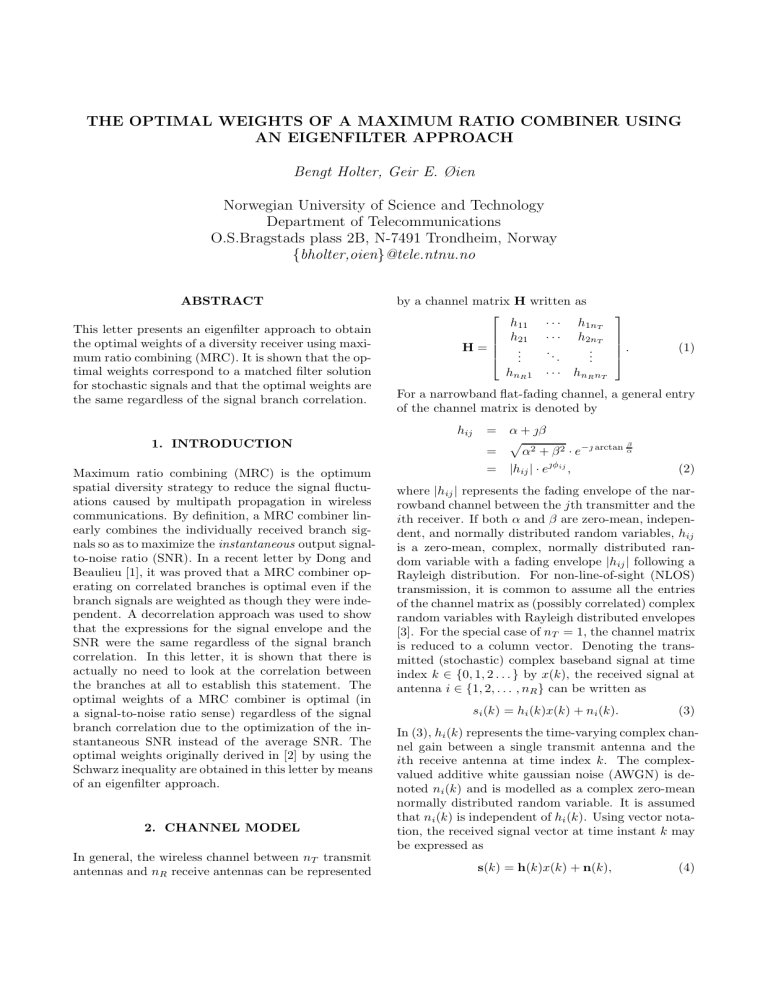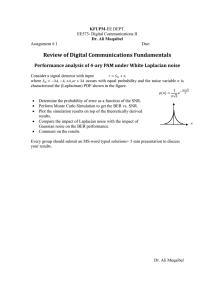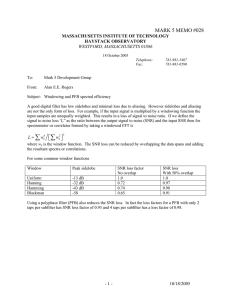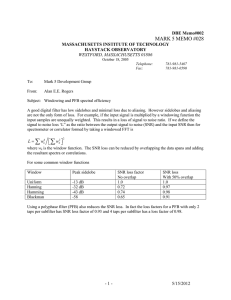as a PDF
advertisement

THE OPTIMAL WEIGHTS OF A MAXIMUM RATIO COMBINER USING
AN EIGENFILTER APPROACH
Bengt Holter, Geir E. Øien
Norwegian University of Science and Technology
Department of Telecommunications
O.S.Bragstads plass 2B, N-7491 Trondheim, Norway
{bholter,oien}@tele.ntnu.no
ABSTRACT
This letter presents an eigenfilter approach to obtain
the optimal weights of a diversity receiver using maximum ratio combining (MRC). It is shown that the optimal weights correspond to a matched filter solution
for stochastic signals and that the optimal weights are
the same regardless of the signal branch correlation.
1. INTRODUCTION
Maximum ratio combining (MRC) is the optimum
spatial diversity strategy to reduce the signal fluctuations caused by multipath propagation in wireless
communications. By definition, a MRC combiner linearly combines the individually received branch signals so as to maximize the instantaneous output signalto-noise ratio (SNR). In a recent letter by Dong and
Beaulieu [1], it was proved that a MRC combiner operating on correlated branches is optimal even if the
branch signals are weighted as though they were independent. A decorrelation approach was used to show
that the expressions for the signal envelope and the
SNR were the same regardless of the signal branch
correlation. In this letter, it is shown that there is
actually no need to look at the correlation between
the branches at all to establish this statement. The
optimal weights of a MRC combiner is optimal (in
a signal-to-noise ratio sense) regardless of the signal
branch correlation due to the optimization of the instantaneous SNR instead of the average SNR. The
optimal weights originally derived in [2] by using the
Schwarz inequality are obtained in this letter by means
of an eigenfilter approach.
2. CHANNEL MODEL
In general, the wireless channel between nT transmit
antennas and nR receive antennas can be represented
by a channel matrix H written as
h11 · · · h1nT
h21 · · · h2nT
H= .
..
..
..
.
.
hnR 1 · · · hnR nT
.
(1)
For a narrowband flat-fading channel, a general entry
of the channel matrix is denoted by
hij
=
α + β
β
α2 + β 2 · e− arctan α
=
|hij | · eφij ,
=
(2)
where |hij | represents the fading envelope of the narrowband channel between the jth transmitter and the
ith receiver. If both α and β are zero-mean, independent, and normally distributed random variables, hij
is a zero-mean, complex, normally distributed random variable with a fading envelope |hij | following a
Rayleigh distribution. For non-line-of-sight (NLOS)
transmission, it is common to assume all the entries
of the channel matrix as (possibly correlated) complex
random variables with Rayleigh distributed envelopes
[3]. For the special case of nT = 1, the channel matrix
is reduced to a column vector. Denoting the transmitted (stochastic) complex baseband signal at time
index k ∈ {0, 1, 2 . . . } by x(k), the received signal at
antenna i ∈ {1, 2, . . . , nR } can be written as
si (k) = hi (k)x(k) + ni (k).
(3)
In (3), hi (k) represents the time-varying complex channel gain between a single transmit antenna and the
ith receive antenna at time index k. The complexvalued additive white gaussian noise (AWGN) is denoted ni (k) and is modelled as a complex zero-mean
normally distributed random variable. It is assumed
that ni (k) is independent of hi (k). Using vector notation, the received signal vector at time instant k may
be expressed as
s(k) = h(k)x(k) + n(k),
(4)
where s(k), h(k), and n(k) are all column vectors. For
notational convenience, data associated with time k
will from now on be indicated by subscripts, such as
sk , hk , and nk . In the next section, an eigenfilter
approach is used to obtain the optimal linear combination of the entries of sk in order to maximize the
output SNR.
3. EIGENFILTER APPROACH
With a linear combining technique, the output of the
maximum ratio combiner at time instant k may be
expressed as
yk
= w H sk
(5)
= wH hk xk + wH nk ,
(6)
where w ∈ CnR are the (as yet unknown) weights
of the linear combiner and the superscript H denotes
Hermitian transpose. In a fading channel, the received SNR level will vary due to random fluctuation
of the signal power. This random fluctuation is described by the fading envelope |hij |. In this letter, the
fading envelopes associated with the separate antenna
branches are represented by the entries of the channel
vector h. In general, the channel vector h is treated
as a multivariate random variable with possibly correlated entries. However, the current (observed) channel vector at time instant k is always treated as a
single channel realization of the random variable h.
Invoking this assumption together with the assumption of an average transmit power PT , the instantaneous received signal power S at the output of the
MRC combiner at time instant k can be expressed as
S = PT · wH hk hH
k w.
(7)
The expected output noise power N may be expressed
as
N = E{|wH n|2 } = wH Rn w,
(8)
where Rn = E{nnH }. Using (7) and (8), the instantaneous output SNR from the MRC at time instant k
can be expressed as
γk,MRC =
PT · wH hk hH
PT · wH R̂k w
S
kw
=
=
,
N
w H Rn w
w H Rn w
(9)
where R̂k = hk hH
k . Note that the numerator in (9)
represents the output signal power for a single observed channel realization hk of the random variable
h at time instant k. The optimization problem is now
to determine the coefficient vector w so as to maximize the instantaneous output SNR for the current
observed channel vector hk . In the next two subsections, the optimum weight vector solution for both
equal and unequal branch noise powers will be derived.
3.1. Equal noise power
In the following, we assume equal noise power at each
of the branches, and also that the noise is uncorrelated
between the branches. This means that the noise correlation matrix introduced in the previous section can
be represented as Rn = σ 2 I, where σ 2 represents the
noise power common to all branches and I represents
the identity matrix. Taking the conjugate derivative
∂/∂w∗ [4] of (9) with respect to the weight vector w,
we obtain the following set of implications:
∂γk,MRC
∂w∗
2
=
H
PT · R̂k w(σ w w) =
⇓
R̂k w
0
=
σ 2 w(PT · wH R̂k w)
wH R̂k w
wH w
w.
(10)
H
kw
Introducing λ = wwR̂
and using the result of (10)
Hw
in (9), we obtain
γk,MRC =
PT · wH λw
PT · λ
PT · wH R̂k w
=
=
.
2
H
2
H
σ w w
σ w w
σ2
(11)
It can be seen that the maximum value of the output
max
SNR is given as PT ·λ
, where λmax is the largest
σ2
eigenvalue of the matrix R̂k . The optimal weight vector that yields the maximum output SNR is given by
the eigenvector associated with λmax . To obtain a
non-trivial solution of (10), w must reside within the
column space (range) of R̂k , denoted R(R̂k ). Since
all the columns in R̂k are linear combinations of the
single vector hk , it is a rank one matrix and R(R̂k ) =
{hk }. Since R(R̂k ) consists of just a single vector, the
only way of obtaining a non-trivial solution is to select wopt = c · hk for an arbitrary c = 0. Inserting
this result into the left side of (10), we obtain
||hk ||2 c · hk = λmax wopt .
(12)
The maximum eigenvalue is thus identified as λmax =
||hk ||2 . Using this result in (11), the maximum output
SNR is given by
max
γk,MRC
PT · ||hk ||2
=
=
σ2
nR
i=1
PT · |hk,i |2
=
σ2
nR
γk,i ,
i=1
(13)
where |hk,i | and γk,i denote the fading envelope and
the instantaneous SNR at the ith branch at time index
k respectively. This result confirms that the output
SNR may be expressed as a sum of the SNR values
from the individual branches, which is a specific feature of the MRC combiner [2].
3.2. Unequal noise power
With unequal noise power in the diversity branches,
the SNR expressed in (9) can not be simplified. Taking the conjugate derivative of (9) with respect to the
weight vector w, we obtain the following set of implications:
∂γk,MRC
∂w∗
H
PT · R̂k w(w Rn w)
R̂k w
= 0
= (PT · wH R̂k w)Rn w
⇓
wH R̂k w
Rn w. (14)
=
w H Rn w
H
w R̂k w
Introducing λ = w
H R w and exploit the fact that
n
Rn is nonsingular (diagonal matrix with all entries
σi2 > 0), (14) may be expressed as
R−1
n R̂k w = λw.
(15)
Using these optimal weights, the maximum output
SNR from a MRC combiner may be expressed as
max
=
γk,MRC
PT ·||hk ||2
σ2
−1
PT · hH
k Rn hk
Equal noise power
Unequal noise power
(20)
Looking at the inner product in (5), the actual weights
used in the inner product are the complex conjugate
of the weights presented in (19). The optimal weights
are then in agreement with the results presented in [2].
Since the solutions in this section is linked to an eigenvalue problem, the optimal (spatial) filter obtained
using this method is commonly called an eigenfilter.
As noted in [4], the optimum filter characterized in
this way may be viewed as the stochastic counterpart
of a matched filter.
4. INSTANTANEOUS VERSUS AVERAGE
SNR
In [1], it is stated that the optimal performance of
a MRC diversity receiver can be achieved without
The optimal weight vector is now the eigenvector of
−1
−1
H
decorrelating the correlated input signals, but weightthe matrix Rn R̂k = Rn hk hk corresponding to the
ing the input branch signals as though they were inlargest eigenvalue of the same matrix. By letting
−1
dependent. This statement seems to indicate (i) the
hk = Rn hk , the current eigenvalue problem may
possible existence of several optimal weight solutions
be expressed as
depending on signal branch correlation (ii) that the
optimal weights must be obtained by incorporating
R̂k w = λw,
(16)
the correlation properties in the optimizing procedure.
However, in this letter, the optimal weight vector is
where R̂k = hk hH
.
A
non-trivial
solution
of
this
k
shown to be the same as in the original paper by Brenequation is obtained if w resides within the column
nan [2] without taking the correlation properties of h
space of R̂k , denoted R(R̂k ). Every matrix of the
into account.
simple form hk hH
has
rank
one
[5]
and
the
column
k
Regarding assertion (ii), the way to incorporate
space R(R̂k ) = {hk }. As in the previous section, the
the correlation properties into the optimizing proceonly choice to obtain a non-trivial solution is to select
dure is to optimize the average SNR instead of the
wopt = c · hk for an arbitrary c = 0. Inserting this
instantaneous SNR. If such an approach had been
result into the left side of (16), we obtain
pursued in this letter, the eigenvalue problem would
−1
have contained the correlation matrix Rh = E[hhH ]
hH
R
h
c
·
h
=
λ
w
,
(17)
k
max
opt
k
n
k
instead of the (instantaneous) matrix R̂k = hk hH
k.
and the maximum eigenvalue can be identified as λmax = With the assumption of correlated branch signals how−1
hH
k Rn hk . Inserting the optimal weight vector wopt =
ever, Rh would be a rank one matrix and the opti
c · hk = c · R−1
n hk into (9), we obtain
mal weight vector solutions in (19) still apply. With
the assumption of uncorrelated branch signals, Rh is
nR
nR
PT · |hk,i |2
max
H −1
a diagonal (full rank) matrix and its eigenvalues are
=
γk,i ,
γk,MRC = PT · hk Rn hk =
2
σ
placed along its main diagonal. The optimal weight
i
i=1
i=1
vector is still the eigenvector corresponding to the
(18)
largest eigenvalue of the matrix Rh . Assuming equal
i.e., as in the previous subsection, the output SNR
noise power in all branches for simplicity, the eigenvalmay be expressed as the sum of the SNR values from
ues are equal to the individual channel powers. The
the individual branches. To summarize, we have obsolution is then to select the single channel realiztained the following optimal weights:
ing the largest channel gain. This selection scheme is
commonly known as selection diversity and obviously,
hk
Equal noise power
the results obtained by using average SNR are not in
(19)
wopt ∝
R−1
Unequal noise power
n hk
agreement with the results of MRC presented in [2].
Since the correlation properties of the channel vector
h in this paper have no influence on the optimality of
the weight vector solution, nor is there any need to
perform the decorrelation approach suggested in [1]
in order to establish the fact that performance measures of MRC combining are identical for both correlated and uncorrelated branches. Even though the
optimal solution for instantaneous SNR is the same
regardless of the signal branch correlation, the actual
performance of a MRC combiner on average will be
highly dependent on the correlation properties.
5. CONCLUSION
An eigenfilter approach is used to obtain the optimal
weights of a MRC combiner. At the same time, it is
proved that the optimal solution is optimal regardless of the correlation between the diversity branches.
This was recently established in [1] using a decorrelation approach.
6. REFERENCES
[1] X. Dong, N. C. Beaulieu, “Optimal maximal ratio combining with correlated diversity
branches,” IEEE Communications Letter, vol.
6, no. 1, pp. 22–24, 2002.
[2] D. G. Brennan, “Linear diversity combining techniques,” Proc. IRE, vol. 47, pp. 1075–1102, 1959.
[3] M. K. Simon, M.-S. Alouini, Digital communication over fading channels: A unified approach to
performance analysis, John Wiley & Sons, Inc.,
2000.
[4] S. Haykin, Adaptive filter theory, Prentice Hall,
Inc., 2001.
[5] G. Strang, Linear algebra and its applications,
Harcourt Brace Jovanovich, Inc., 1988.




